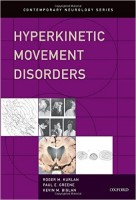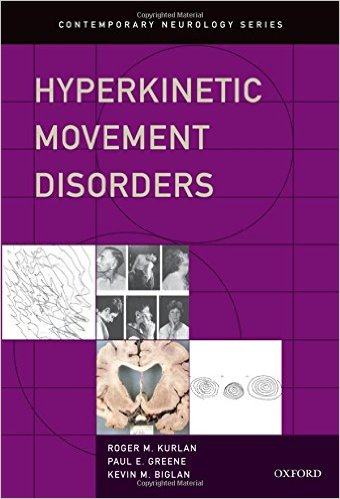 A Volume in the Contemporary Neurology Series
A Volume in the Contemporary Neurology Series
Authors: Roger M. Kurlan, MD: Paul E. Greene, MD; and Kevin M. Biglan, MD
Publisher: Oxford University Press – 197 pages
Book Review by: Nano Khilnani
This book presents current information on a range of conditions that primarily involve involuntary movements. The authors, three internationally-recognized experts, discuss clinically-focused options in the study and treatment of these neurological and psychiatric disorders.
They provide knowledge that can assist you, the student or clinician, understand, diagnose and treat patients who have these hyperkinetic movement abnormalities. Their approach is comprehensive yet practical in that the objective is to offer clinical care.
We list below the titles of its chapters to give you an overview of the scope of topics covered in this slim book of less than 200 pages:
- The Basal Ganglia
- Tremor
- Dystonia: Part 1
- Dystonia: Part 2
- Chorea, Athetosis, and Ballism
- Tourette’s Syndrome
- Habits, Mannerisms, Compulsions, and Stereotypes
- Myoclonus and Asterixis
- Rest Legs Syndrome
- Drug-Induced Movement Disorders
- Wilson’s Disease
- Peripherally Induced Movement Disorders
- Psychogenic Hyperkinetic Movement Disorders
- The Ataxias
One way to classify movement disorders, write the authors in the Preface, is to label the patients who have them, as either hypokinetic or hyperkinetic, or those who don’t move enough, or those who move too much. These abnormalities are not due to pyramidal dysfunction, such as for example, lesions of the corticospinal tract that result in weakness or paralysis or spasticity.
The movement disorders that are the subject of study in this book are part of the extrapyramidal motor control system. This system consists largely of the basal ganglia and their connections. The basal ganglia, sometimes called basal nuclei, are located in the base of the forebrain, interconnected with the cerebral cortex, thalamus, and brainstem, as well as other areas of the brain.
These ganglia, part of the cerebrum, not only control involuntary and voluntary motor movements, procedural learning, and routine behaviors such as eye movements, but are also involved in cognition, and even emotion.
In chapter 1, The Basal Ganglia, Dr. Kurlan writes that increasing basal ganglia output is like “applying the brakes” on movement. He explains that excessive basal ganglia output results in slowed, rigid and tremulous movement as seen in hypokinetic movements of those who have Parkinson’s disorders. On the other hand, inadequate output causes hyperkinetic (excessive) involuntary movements.
He writes that more recent evidence shows that the “braking” function of the basal ganglia also applies to the control of attention, emotions, impulses, motivation, and thought. Inadequate braking results in problems such as attention deficits, impulse control issues, mood disorders, and obsessions.
This chapter’s components are:
- General Overview
- Anatomy
- Clinical Implications
- References
Other chapters have similar structures, and instead of an overview you may find an Introduction or a History at their beginning, and discussions of various topics and subtopics before the References section. Brain scans, charts, figures, photos, sketches, tables and other types of illustrations help you understand and retain the material in this book.
This book provides you the neurologist, the knowledge you want for the decisions you need to make on the care of your patients. It is a clearly-written, practical, updated, and well-referenced resource. It cites important studies on various subjects to help you address your concerns and answer your questions.
Editors:
Roger M. Kurlan, MD is Director of the Movement Disorders Program in the Atlantic Neuroscience Institute at Overlook Medical Center in Summit, New Jersey. He has published more than 200 articles and edited four books. He is recognized internationally for his clinical and research expertise in neurological movement disorders. He is a founding member of the Parkinson Study Group and leader of the Tourette Syndrome Study Group.
Paul E. Greene, MD works in the Department of Neurology at Mount Sinai School of Medicine in New York, New York. He is involved in clinical research in several areas of Movement Disorders, including the treatment of Parkinson’s disease and dystonia and the therapeutic use of botilunim toxin. He had completed a fellowship in Movement Disorders under Dr. Stanley Fahn at Columbia University 1in 1988.
Kevin M. Biglan, MD, PhD is Professor of Neurology and Associate Chair for Clinical Research in the Department of Neurology at University of Rochester School of Medicine and Dentistry in Rochester, New York. His current research interests focus on identifying clinical phenotypes in pre-manifest Huntington’s disease, and in Parkinson’s disease, including identifying disease-modifying therapies in HD and PD.







